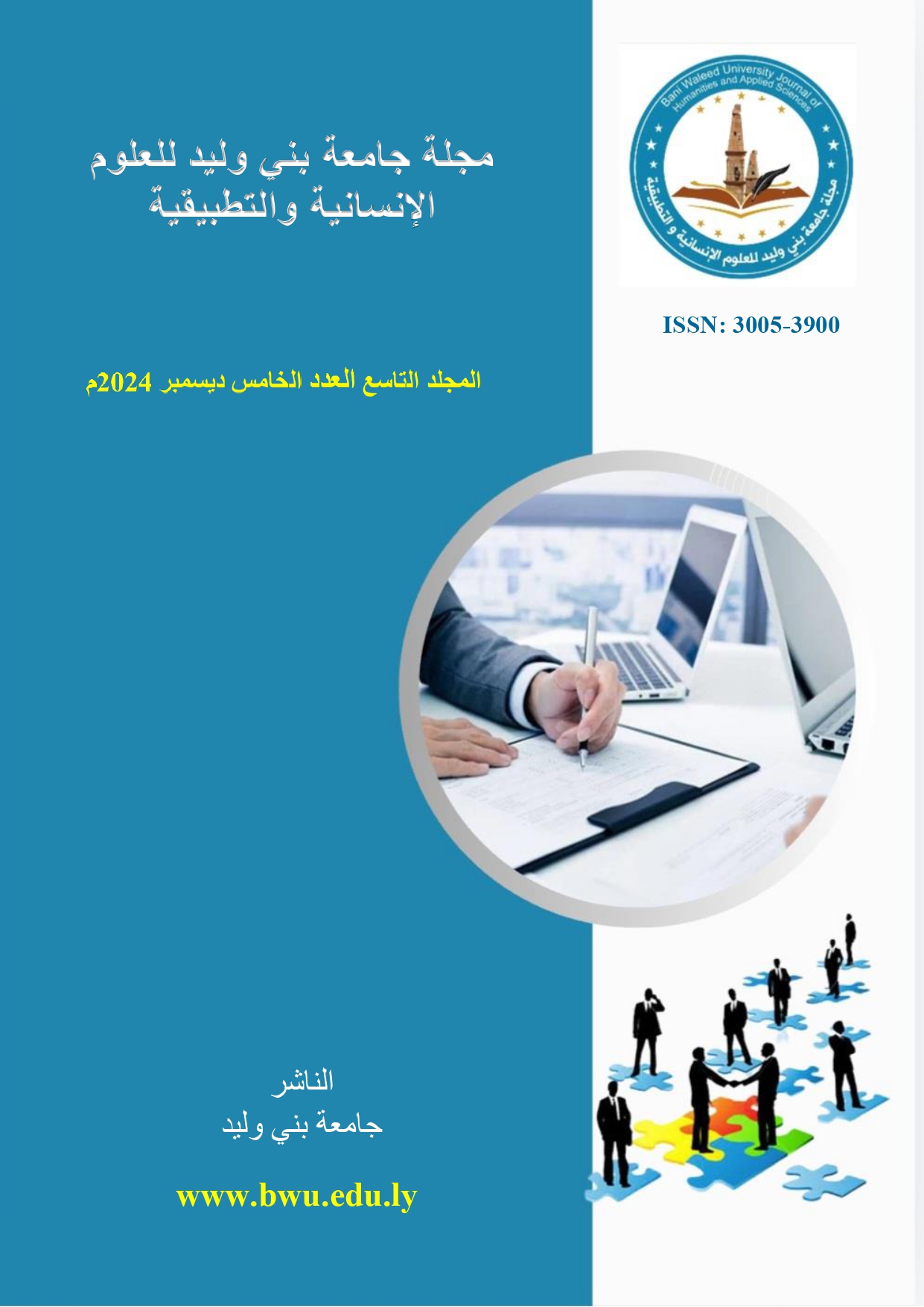تباين توزيع القوى العاملة حسب النشاط الاقتصادي لسكان ليبيا للفترة من 2012 -2022
DOI:
https://doi.org/10.58916/jhas.v9i5.543الكلمات المفتاحية:
القوى العاملة، النشاط الاقتصادي، نمو السكان، التركيب النوعي والعمري، القطاع الوظيفي.الملخص
تهتم الدراسة بالتباين المكاني والزماني لتوزيع القوى العاملة علي حسب الأنشطة الاقتصادية لسكان ليبيا على مستوى المناطق بحسب بيانات مصلحة الإحصاء والتعداد، ونتائج مسح القوة العاملة (للتشغيل والبطالة)، لسنتي 2012- 2022 اعتمدت الدراسة التصنيف التفصيلي حسب قطاعات النشاط الاقتصادي المختلفة ذي السبعة عشر نشاطا، إضافة الى التصنيف الثلاثي للأنشطة الاقتصادية. وقد أكدت الدراسة أن هناك تباينا زمانيا ومكانيا على مستوى منطقة الدراسة وكانت تقف وراء هذا التباين عوامل متعددة كان من اهمها سوء توزيع المشاريع التنموية والاقتصادية وتوقفها في تلك الفترة وذلك لدخول الدولة لمرحلة جديدة، إضافة إلى سوء الأحوال الأمنية.
أظهرت الدراسة أن هناك تفاوت في نسبة القوى العاملة حسب الأنشطة الاقتصادية، وتبين أن أعلى نسبة سنة 2012 كانت في النشاط الإدارة العامة والدفاع والضمان الاجتماعي بنسبة (34.56%) وكانت أعلى نسبة لمشاركة الذكور (43.54 %) وتقل النسبة الاناث في هذا النشاط تصل (15.32 %) ثم زادت هذه النسبة سنة 2022 للنشاط الإدارة العامة والدفاع والضمان الاجتماعي الالزامي لهذا النشاط وأخذ أعلى نسبة مشاركة لتصل إلى (44.1 %) ، أعلى نسبة المشاركة للذكور حصل عليها النشاط الادارة العامة والدفاع والضمان الاجتماعي الالزامي بنسبة (53.7%)، أما نسبة المشاركة الاناث فبلغت (29.4%)، ولعل ذلك راجع إلى محدودية القطاع الوظيفي في هذه الفترة ودخول الدولة في صراع سياسي والتحاق معظم الشباب بالوحدات العسكرية خصوصاً أثناء نشوب حرب طرابلس، وما اتبعها من صراعات ونزاعات محلية، مما يدل على تناقص المستمر في نسبة القطاع الزراعي أمام الزيادة السكانية ويقابلها وجود خلخل في عمل المنشآت الصناعية، ما بين عملها وتوقفها بين الحين والآخر بسبب الظروف الأمنية، يليها قطاع التعليم بنسبة (32.1%)، لسنة 2012 حيث تحصلت مشاركة الاناث في هذا القطاع بنسبة عالية تصل (65.31%)، أما الذكور فكانت المشاركة بنسبة (16.48%)،فقد تناقص مشاركة هذا القطاع سنة 2022 بنسبة (26.8%) فتبين التوزيع النسبي لذكور (12.6%) اما الاناث بنسبة (48.8%) .
في حين كانت أعلى نسبة لسنة 2022 في قطاع الادارة العامة والدفاع والضمان الاجتماعي، لجنس الذكور بنسبة(53.7%)، أما أعلى نسبة للإناث فقد مثلها قطاع التعليم بنسبة(65.31%) لسنة 2012، ويعود سبب ارتفاعها إلى تحول العاملين من قطاع الزراعة والصناعة إلى الخدمات بعد تدهور الزراعة وتوقف أغلب المصانع الحكومية عن العمل، وأن غالبية العاملين في المناطق الحضرية بالمنطقة يعملون ضمن نشاط الخدمات، كذلك توجه أغلب العاملين من سكان الريف في ليبيا إلى نشاط الخدمات .
التنزيلات
المراجع
- احميد ساسي، التغيرات السكانية في ليبيا منذ 1954-1999، (1999)رسالة دكتوراه غير منشورة، جامعة عين شمس، كلية الآداب، قسم الجغرافيا، 34 .
- الأمم المتحدة في ليبيا تصدر تقرير نتائج عام2022-وتطلق-موقعاً-إلكترونياً-جديدhttps://unsmil.unmissions.org/ar
- خالد محمد بن عمور،( 2014)، العيوب الجيوبوليتيكية للدولة الليبية وأثرها على إنشاء التقسيمات الإدارية، دراسة في الجغرافيا السياسية، مجلة كلية الآداب جامعة طنطا،، العدد 27 ، 65.
- وزارة التخطيط، مصلحة الإحصاء والتعداد،(2012 – 2022).نتائج مسح القوة العاملة (للتشغيل والبطالة).
- وزارة التخطيط، مصلحة الإحصاء والتعداد،(2012- 2022)، نتائج مسح القوة العاملة (للتشغيل والبطالة)، 18-20.
- Abuhadra, Dia S., and Tawfik T. Ajaali (2014). Labour Market and Employment Policy in Libya. Villa Gualino: European Training Foundation. Available at https://www.etf.europa.eu/sites/default/files/m/ 01BE9A2F283BC6B2C1257D1E0041161A_Employment%20policies_Libya.pd .
- الهيئة العامة للمعلومات (2018) التقرير الخامس للتنمية البشرية تحديات التنمية في ليبيا (طرابلس الهيئة العامة للمعلومات ، ص 143.
- https://omu.edu.ly/archives/3905 ندوة علمية بعنوان ،2020 ،جائحة كورونا في ليبيا: الواقع والتطلعات.
- وزارة التخطيط، مصلحة الإحصاء والتعداد،(2022) نتائج مسح القوة العاملة (للتشغيل والبطالة)، 65.
- Sundararajan, Aurn. The Sharing Economy:(2016) The End of Employment and the Rise Crowd- Based Capitalism. MIT Press. Cambridge.
- Clarke, J.I. (1975)." Population Geography", 2nd ed. Porgamon Press, oxford.
-12 محمد فايز العيسوي،(2002) أسس جغرافية السكان، دار المعرفة الجامعية، الإسكندرية، 319.
- عبد الله عطوي ،(2000) جغرافية السكان ، دار النهضة العربية للطباعة والنشر، بيروت، 185.
- مهدي ناصر حسين الكناني،(2013) التحليل الجغرافي للتركيب الاقتصادي واتجاهاته في محافظة النجف باستخدام نظم المعلومات الجغرافية، رسالة ماجستير (غير منشورة) مقدمة إلى كلية التربية للبنات، جامعة الكوفة ، 33.
- رشود بن محمد الخريف، (2005)التركيب العمري والنوعي لسكان المملكة العربية السعودية، بحوث جغرافية)، مجلة الدارة. العدد 25، الرياض، 6.
- مختار محمد مختار الحسانين،(2017)، التركيب الاقتصادي للسكان بمحافظة الدقهلية اطروحة دكتوراه غير منشورة جامعة اسيوط - كلية الآداب - قسم الجغرافية ،203.
- وزارة التخطيط، مصلحة الإحصاء والتعداد،(2012 -2022)، نتائج مسح القوة العاملة (للتشغيل والبطالة)، 63 -55.
- فتحي أبو عيانة،(2008)، جغرافية السكان أسس وتطبيقات، ط 4، دار المعرفة الجامعية، الاسكندرية، 321.
- عباس السعدي،(2002)، جغرافية السكان، ج2، دار الكتب للطباعة والنشر، بغداد، 76.
- رمضان عبدالله الشبه و مصطفى مسعود حدود،(2015)، أسباب عدم التوافق بين مخرجات التعليم العالي متطلبات سوق العمل في ليبيا المجلة الجامعية، المجلد الثالث، العدد السابع عشر، جامعة الزاوية، 98 – 104.
- Braun, G. and Jones, A., Libya - Building the future with youth: Challenges for education and employability, Deutsche Gesellschaft für Internationale Zusammenarbeit (GIZ), 2011. Last accessed April 2014 at: www.giz.de/en/ downloads/giz2013-0297en-libya youth.pdf
- Calice, P., T. Benattia, A. Carriere and E. Davin (2015), Simplified Enterprise Survey and Private Sector Mapping: Libya 2015, World Bank Group, Washington, DC. http://documents.worldbank. org/curated/en/2015/09/25016718/simplified-enterprise-survey-privatesector-mapping- libya-2015.
-23 وزارة التخطيط، مصلحة الإحصاء والتعداد،(2022)نتائج مسح القوة العاملة (للتشغيل والبطالة)، 55.













